Figure 3.
Dopamine (DA) in the nucleus accumbens (NAcc) is involved in the amphetamine (AMPH)-induced impairment of pair bonding. A) After 24hrs of mating, intact and saline-treated (0.0; 1 injection/day/3 days) male prairie voles spent significantly more time in side-by-side contact with their familiar partner than a stranger (i.e., formed partner preferences). However, males treated with 1.0 or 5.0 mg/kg AMPH (1 injection/day/3 days) spent an equal amount of time in contact with the partner as with the stranger. These results demonstrate that repeated AMPH exposure inhibits mating-induced partner preference formation in male prairie voles. B) Male prairie voles treated with AMPH (1.0mg/kg/day/3 days) had higher levels of DA D1 receptor (D1R) mRNA (top image) and protein expression (bottom image) in the NAcc than saline-treated controls. Quantitative analysis demonstrated that these differences were statistically significant (graph on the right). C) Pair bonded (Paired) male prairie voles have significantly higher levels of D1R binding in the NAcc than sexually-naïve (Naive) males. D) Pair bonded male prairie voles that received intra-NAcc injections of cerebral spinal fluid (CSF) showed low levels of aggression (data includes the frequency of both offensive and defensive aggression) toward their partner, but high levels of aggression toward a stranger (i.e., selective aggression). Pharmacological blockade of NAcc D1Rs (D1R Ant) in pair bonded males abolished aggression toward a stranger, indicating that NAcc D1R activation mediates selective aggression in pair bonded voles. E) AMPH-treated sexually-naïve male prairie voles display significantly more aggression (data includes the frequency of both offensive and defensive aggression) toward both familiar and unfamiliar conspecific females than saline-treated controls. Picture illustrates a male prairie vole (left) displaying aggression toward an unfamiliar female prairie vole (right). Bars with different Greek letters differ significantly from each other. *: p<0.05; **: p<0.01. Adapted from (Aragona et al., 2006; Gobrogge et al., 2009; Liu et al., 2010).

